Types of Glassware Used in Bars and Restaurants
Glassware is an essential part of any bar or restaurant. It not only serves functional purposes, but it also adds to the overall aesthetic appeal of the establishment. There are various types of glassware that are commonly used in bars and restaurants, each with its own unique purpose.
One of the most common types of glassware is the pint glass, which is used to serve beer. These glasses are typically made of thick glass and have a capacity of 16 ounces. Another popular type of glassware is the wine glass, which comes in various shapes and sizes depending on the type of wine being served.
For cocktails, there are several types of glassware that bartenders use. The most common are the highball glass, which is used for mixed drinks that contain soda or other carbonated beverages, and the martini glass, which is used for serving martinis and other cocktails that are typically served “up” (without ice).
Shot glasses are also commonly used in bars and restaurants for serving small amounts of liquor or liqueurs. These glasses come in various sizes and shapes, and are often used in conjunction with other glassware.
The type of glassware in which a drink is served greatly affects its presentation. Some hotels have begun to use the same style of glassware for several beverages. This can reduce the number of kinds of glassware that they must maintain in inventory.
Full Service Hotels normally avoid mass-produced glassware which is generally thick and many have imperfections even though it is not that expensive when compared to fine, expensive products.
However, hotel chains that consider value for money as an important criterion accept such glassware. Additionally, management should consider function as well as form when purchasing glassware for their f&B operations.
Tips while selecting glassware:
- Glass with Rolled edges and rims reduces problems like chipping and cracking.
- Glass-wares with thick glass and certain shapes can also reduce breakage.
- Stemmed glasses are very likely to break, so while selecting stemmed glass choose designs that are harder to tip over.
Types of Glassware used in bars
1. Collins / Highball

8oz. – 16oz ( 230 ml – 473 ml)Used for serving juices, aerated drinks, Gin and tonic etc.
“Collins/Highball,” which are types of cocktail glasses and also names of specific cocktails. Let me provide you with information on both:
- Collins Glass:
- A Collins glass is a tall, narrow glass typically used for serving mixed drinks, especially those that are carbonated. It is named after the Tom Collins cocktail, which is often served in this type of glass.
- The glass is usually around 10 to 14 ounces in capacity and is characterized by its straight sides and relatively narrow opening. This design is well-suited for drinks with ice and carbonated mixers.
- Highball:
- “Highball” refers to both a type of glass and a category of cocktails. The highball glass is tall and slender, similar to the Collins glass. It is commonly used for serving cocktails that include a spirit and a larger portion of a non-alcoholic mixer.
- Highball cocktails are often simple and refreshing, with a spirit like whiskey or vodka mixed with a larger volume of soda, ginger ale, or tonic water. The name “highball” originally referred to a railroad signal indicating that the track ahead was clear, and the term was later applied to these tall drinks.
2. Rock Glass or Tumbler
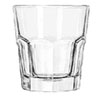
6oz. – 10oz. (177ml – 295ml)Used for serving drinks ‘On the Rock’s’
Both “rock glass” and “tumbler” are terms often used interchangeably to refer to a specific type of glassware commonly used for serving alcoholic beverages. However, there can be subtle differences in their usage.
- Rock Glass:
- The term “rock glass” is often associated with short, wide glasses with a thick base. It’s commonly used for serving drinks “on the rocks,” which means over ice.
- Rock glasses are typically used for cocktails like Old Fashioned, Whiskey Sour, or any drink that is traditionally served over ice in a shorter glass.
- Tumbler:
- The term “tumbler” is a more general one and can refer to various types of flat-bottomed glasses with no stem. It’s a broader category that includes different sizes and shapes.
- Tumblers can be used for a variety of beverages, including water, juice, soft drinks, and cocktails. They come in different sizes, and some may have a slightly tapered shape.
3. Whisky / Shooter
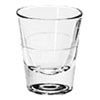
1oz. – 2oz. (29ml – 59ml)Used for single measures of liquor and ‘shooters’.
“Whisky glass” and “shooter” refer to distinct types of glassware, each designed for serving specific types of drinks.
- Whisky Glass:
- A whisky glass is designed to enhance the experience of sipping and savoring whisky. There are different types of whisky glasses, and some popular ones include the Glencairn glass, tumbler, and snifter.
- The Glencairn glass, for example, has a tulip shape that concentrates the aromas, making it suitable for enjoying the nuances of whisky. Tumblers are also commonly used for whisky and are known for their broad, flat shape.
- The choice of a whisky glass often depends on personal preference and the type of whisky being served.
- Shooter Glass:
- A shooter glass, on the other hand, is a small, narrow glass typically used for serving shooters or shots of alcohol. These are small, concentrated servings of spirits or liqueurs.
- Shooter glasses are often used for quick consumption of a single, strong drink. They come in various shapes and sizes, but they are generally smaller than traditional drinking glasses.
In summary, a whisky glass is designed for sipping and enjoying the flavors of whisky, while a shooter glass is intended for quickly consuming small amounts of strong spirits or liqueurs. The choice between them depends on the type of drink you are serving and the drinking experience you want to provide.
4. Beer Schooner
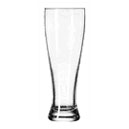
12oz. – 14oz. (354ml – 414ml)Used for Pilsner, and bottled beers.
A beer schooner is a type of glassware specifically designed for serving beer. It has a distinctive shape characterized by a short, wide bowl and a thick stem. The design allows for a larger serving size compared to some other beer glasses.
Key features of a beer schooner include:
- Shape: The bowl of the glass is often wider at the top and narrower towards the base, resembling the shape of a boat or a tulip. This design is meant to showcase the beer’s aromas while providing a comfortable grip.
- Capacity: Beer schooners typically have a larger capacity compared to standard pint glasses, making them suitable for serving generous amounts of beer.
- Stem: Schooners have a short stem, allowing the drinker to hold the glass without warming the beer with their hands.
- Use: They are commonly used for serving a variety of beers, including ales, lagers, and sometimes cocktails. The wide bowl allows for a good amount of beer to be poured, and the shape enhances the drinking experience.
It’s worth noting that the term “schooner” can vary in meaning and design in different regions. In some places, it may refer to a smaller beer glass resembling a mini-pint, while in others, it refers to the larger, boat-shaped glass described above. The specific design and size can differ based on cultural and regional preferences.
5. Beer Mug
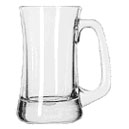
12oz. – 14oz. (354ml – 414ml)Used for ½ measure of draft beer.
A beer mug is a traditional and sturdy type of glassware designed for serving beer. It typically has a thick handle, a substantial base, and a large, cylindrical body. Beer mugs are known for their robustness and are often associated with a classic and rustic drinking experience. Here are some key features:
- Material: Beer mugs are commonly made of glass, although you can also find them in other materials like ceramic or even metal. The choice of material can influence the overall feel and appearance of the mug.
- Size: Beer mugs come in various sizes, but they typically have a larger capacity compared to standard pint glasses. The larger size allows for serving generous portions of beer.
- Handle: One distinctive feature of a beer mug is its handle, which provides a comfortable grip. This is particularly practical when serving beers that are meant to be enjoyed at colder temperatures, as it prevents the heat from the drinker’s hand from warming the beer.
- Wide Opening: Beer mugs often have a wide opening at the top, allowing for easy sipping and often enhancing the aroma of the beer.
- Traditional Design: The classic beer mug design is iconic and is often associated with beer gardens, pubs, and traditional beer-drinking settings.
Beer mugs are popular in various beer-drinking cultures around the world, and they are commonly used for serving ales, lagers, and other types of beer. The design of the beer mug contributes to a hearty and enjoyable beer-drinking experience.
6. Beer / Pint
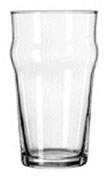
1 Pint (473ml)Used for serving Draft Beer
“Beer” and “pint” refer to both the beverage and the vessel in which it is commonly served, respectively.
- Beer (Beverage):
- Beer is one of the oldest and most widely consumed alcoholic drinks in the world. It is typically made from fermented grains, primarily malted barley, along with water, hops, and yeast.
- There are various styles and types of beer, including ales, lagers, stouts, and more, each with its own unique flavor profile, color, and characteristics.
- Pint (Vessel):
- A pint is a unit of volume measurement, and when referring to beer, it often signifies a specific serving size rather than a particular type of glass. In many countries, a pint of beer is equivalent to 16 fluid ounces (473 milliliters).
- The term “pint” is commonly associated with the standard pint glass, which has a tapered shape with a wide mouth, allowing for easy drinking and a good view of the beer’s characteristics.
- Pint Glass:
- The pint glass is a common vessel used for serving beer in many bars and pubs. It typically has a capacity of 16 ounces (473 milliliters) and comes in various shapes, including the nonic pint glass (with a bulge near the top for grip) and the conical pint glass (tapered towards the top).
- Pint glasses are versatile and can be used for serving various styles of beer, from ales to lagers.
It’s important to note that the size of a “pint” may vary in different countries. For example, a British pint is 20 fluid ounces (568 milliliters), while a U.S. pint is 16 fluid ounces. When ordering a “pint” of beer, it’s essential to know the local standard to understand the actual volume you’ll be served.
7. Red Wine / Bordeaux
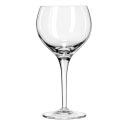
8oz. – 14oz. (236ml – 414ml)Used for serving Red Wine.
“Red wine” and “Bordeaux” refer to both a type of wine and a specific wine region known for producing high-quality red wines.
- Red Wine:
- Red wine is a type of wine made from dark-colored grape varieties. The color of red wine comes from the grape skins, which are left in contact with the juice during the fermentation process.
- There are numerous red wine varieties, each with its own characteristics in terms of flavor, aroma, and body. Common red wine varieties include Cabernet Sauvignon, Merlot, Pinot Noir, Syrah (Shiraz), and Zinfandel, among others.
- Bordeaux:
- Bordeaux refers to a wine region in southwestern France, known for producing some of the world’s most prestigious and sought-after red wines.
- Bordeaux wines are typically blends, combining several grape varieties. The main grape varieties used in Bordeaux red wines include Cabernet Sauvignon, Merlot, Cabernet Franc, Petit Verdot, and Malbec.
- Bordeaux wines are often classified into several quality levels, including Grand Cru Classé (classified growths), and the region is divided into sub-regions like the Left Bank and Right Bank, each with its own terroir and grape varietal preferences.
When someone refers to “Bordeaux” in the context of red wine, they may be talking about red wines from the Bordeaux wine region in France. These wines are known for their complexity, structure, and aging potential. Bordeaux red wines are often associated with flavors such as blackcurrant, plum, tobacco, and cedar, depending on the specific blend and terroir.
8. Wine Glass / All Purpose Glass
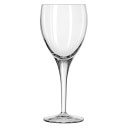
8oz. – 14oz. (236ml – 414ml)Used for serving red wine & white wine
A “wine glass” and an “all-purpose glass” serve different purposes, but the term “all-purpose glass” can sometimes be used to describe a versatile glass that can be used for various types of beverages, including wine. Let’s look at each concept:
- Wine Glass:
- A wine glass is specifically designed for serving wine. Wine glasses come in various shapes and sizes, each tailored to enhance the characteristics of different types of wine.
- Common types of wine glasses include those designed for red wine, white wine, and sparkling wine. For example, red wine glasses typically have a larger bowl to allow the wine to breathe and release its aromas, while white wine glasses may have a slightly smaller bowl to preserve the wine’s cooler temperature.
- All-Purpose Glass:
- An all-purpose glass, on the other hand, is a more general term for a versatile drinking vessel that can be used for a variety of beverages, not just wine. These glasses often have a simpler and more universal design.
- All-purpose glasses are suitable for serving water, juice, soft drinks, and, to some extent, wine. They may have a moderate-sized bowl and are designed to be practical for everyday use.
While wine glasses are tailored for the specific characteristics of different types of wine, an all-purpose glass is more of a general-purpose vessel that can be used for a range of beverages. Some households may opt for all-purpose glasses if they prefer a more straightforward and practical approach to glassware. However, wine enthusiasts often prefer using specialized wine glasses to fully appreciate the nuances of different wines.
9. Champagne Tulip / Champagne FluteFlute: Making a decorative scalloped design on the edge of a pie crust or pastry.
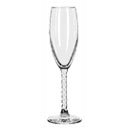
6oz. – 8oz. (177ml – 230ml)Used for serving SoursSours are the mild adds used to neutralize residual alkalinity in fabrics after washing and rinsing...., Champagne and Champagne Cocktails.
The terms “Champagne tulip” and “Champagne flute” refer to specific types of glassware designed for serving Champagne and other sparkling wines. Each has its own distinctive shape, and both are popular choices, but they offer slightly different drinking experiences.
- Champagne Tulip:
- The Champagne tulip, also known as a tulip glass or wine coupe, has a broader bowl with a slightly flared lip. It somewhat resembles a tulip flower, which gives it its name.
- The wider bowl of the Champagne tulip allows for better aeration and enhances the perception of the wine’s aromas. It also provides a larger surface area for the bubbles to dissipate, allowing for a more integrated and aromatic tasting experience.
- While historically popular, some critics argue that the wide opening of the tulip glass may cause the Champagne to lose its effervescence more quickly compared to other glass shapes.
- Champagne Flute:
- The Champagne flute is a tall, narrow glass with a slender, elongated bowl. It is the more traditional and widely recognized glass for serving Champagne.
- The narrow shape of the flute helps to preserve the bubbles in the wine, allowing them to rise in a steady stream. It is believed by many that this design enhances the overall effervescence and maintains the crispness of the sparkling wine.
- Champagne flutes are often preferred for celebrations and formal events due to their elegant appearance.
Ultimately, the choice between a Champagne tulip and a Champagne flute comes down to personal preference. Some people prefer the wider bowl of the tulip for the enhanced aromas, while others favor the classic look and effervescence-preserving qualities of the flute. Both glasses are widely used, and the right choice often depends on the occasion and individual taste preferences.
10. Brandy Snifter
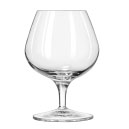
8oz. – 14oz. (236ml – 414ml)Used for serving Brandy and some cocktails.
A brandy snifter is a type of glassware specifically designed for serving and enjoying brandy or other types of distilled spirits. It has a distinctive shape that enhances the tasting experience. Here are the key features of a brandy snifter:
- Bowl Shape: The brandy snifter has a wide, rounded bowl with a relatively short stem. The wide bowl allows the brandy to be swirled easily, releasing its aromas, while the short stem allows the drinker to hold the glass without warming the contents with their hand.
- Narrow Opening: The top of the brandy snifter often has a narrow opening, which helps to concentrate the aromas as the drinker brings the glass to their nose. This design is intended to capture and intensify the complex scents of the brandy.
- Size: Brandy snifters typically have a smaller capacity compared to other types of glasses, as brandy is often served in smaller quantities to savor its rich flavors.
- Wide Base: The glass often has a wide base, providing stability when placed on a surface. This is important as brandy is often enjoyed by cradling the glass in one’s hand, allowing the warmth from the hand to slightly raise the temperature of the brandy, which can enhance its aromatic qualities.
The design of the brandy snifter is intended to optimize the tasting experience of brandy by capturing and concentrating its aromas. It allows the drinker to appreciate the nuances of the spirit, including its flavors and fragrances. The short stem and wide bowl also contribute to the visual appeal and elegance of serving brandy in this type of glass.
11. Sherry Glass / Port Glass
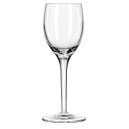
4oz. – 6oz. (118ml – 177ml)Used for serving sherry or port wine.
Sherry glasses and port glasses are specific types of glassware designed to enhance the tasting experience of these fortified wines. While there may be variations in design, the following are general features of each type:
Sherry Glass:
- Shape: Sherry glasses often have a tulip or copita shape. The bowl is typically smaller and more tapered than that of a wine glass, allowing the drinker to concentrate on the complex aromas of the sherry.
- Size: Sherry glasses are smaller than wine glasses, reflecting the fact that sherry is often sipped in smaller quantities. The smaller size also helps maintain the freshness of the wine.
- Stem: Sherry glasses typically have a stem, allowing the drinker to hold the glass without warming the sherry with their hand. The stem helps keep the wine at the desired temperature.
- Function: The design of a sherry glass is tailored to highlight the unique characteristics of sherry, including its diverse styles such as Fino, Amontillado, and Oloroso. The shape concentrates the aromas while the smaller size encourages sipping.
Port Glass:
- Shape: Port glasses can vary in shape, but they often have a wide bowl and a slightly shorter stem compared to wine glasses. The bowl may be broader, especially for styles like Tawny Port, allowing for aeration.
- Size: Like sherry glasses, port glasses are smaller than standard wine glasses. PortsPorts are the openings into washing machines through which detergents can be poured. Also called hop... are often served in smaller quantities, and the smaller size helps showcase the wine’s richness and sweetness.
- Stem: Port glasses typically have a stem for holding the glass without affecting the temperature of the port. The stem also provides an elegant and practical way to enjoy the wine.
- Function: The design of a port glass aims to enhance the tasting experience, allowing the drinker to appreciate the complexity and sweetness of the port. The wide bowl can provide room for the wine to breathe, releasing its aromas.
Ultimately, the choice between a sherry glass and a port glass comes down to personal preference and the specific characteristics of the wine being served. Both glasses are designed to enhance the unique qualities of their respective fortified wines.
12. LiqueurLiqueur - Sweet spirits made with re-distilled fruits or extracts. / Cordial Glass
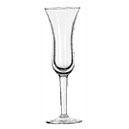
1oz. – 3oz. (29ml – 88ml)Used for serving liqueurs and layered shooters.
A liqueur glass, also known as a cordial glass, is a specific type of glassware designed for serving small amounts of liqueurs or cordials. These glasses are tailored to the characteristics of sweet and often flavorful spirits, offering a vessel that complements the drinking experience. Here are the typical features of a liqueur or cordial glass:
- Shape: Liqueur glasses come in various shapes, but they typically have a small, narrow bowl with a stem. The bowl may have a slight taper or flare at the top, concentrating the aromas of the liqueur.
- Size: Liqueur glasses are small in size, designed to hold a small amount of the concentrated and often potent liqueurs. The smaller size encourages sipping and allows drinkers to enjoy the flavors without overwhelming their palate.
- Stem: Like many other types of glassware, liqueur glasses often have a stem. The stem serves the dual purpose of providing a comfortable grip while preventing the warmth from the drinker’s hand from affecting the temperature of the liqueur.
- Function: The design of the liqueur glass is intended to enhance the tasting experience of sweet and flavorful liqueurs or cordials. The small size allows for controlled sipping, and the shape helps capture and concentrate the aromas.
It’s worth noting that the terms “liqueur glass” and “cordial glass” are often used interchangeably, and the choice of terminology can vary regionally. These glasses are versatile and can be used for serving a variety of liqueurs, cordials, or even small portions of other spirits. The specific design details may vary among different manufacturers, but the key elements focus on enhancing the enjoyment of concentrated and aromatic beverages.
13. Cocktail / Martini Glass
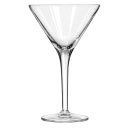
4oz. – 8oz. (118ml – 236ml)Used for serving different varity of Cocktails
Cocktail glasses and martini glasses are distinct types of glassware designed for serving different types of cocktails. While they share some similarities, such as having a stem and a wide bowl, there are specific features that differentiate them.
Cocktail Glass:
- Shape: A classic cocktail glass, often referred to as a “martini glass,” has a wide, shallow, and inverted cone-shaped bowl.
- Stem: It features a stem that allows the drinker to hold the glass without warming the contents with their hand.
- Size: The glass is typically larger than a traditional martini glass, providing more room for the cocktail mixture.
- Use: Cocktail glasses are versatile and can be used for a wide range of cocktails, including martinis, cosmopolitans, daiquiris, and various other mixed drinks.
Martini Glass:
- Shape: A traditional martini glass has a distinctive inverted cone or V-shape, with a wide rim and a relatively small, shallow bowl.
- Stem: Like the cocktail glass, it features a stem to prevent the drinker’s hand from warming the chilled contents.
- Size: The martini glass is often smaller compared to a standard cocktail glass. This smaller size is suitable for serving straight-up cocktails without ice, such as classic martinis.
- Use: Martini glasses are specifically associated with martini cocktails, but they are also used for other cocktails that are typically served without ice.
While the terms “cocktail glass” and “martini glass” are sometimes used interchangeably, it’s worth noting that a “martini glass” is technically a specific type of cocktail glass. The choice of glassware often depends on the type of cocktail being served and personal preferences for presentation. Both glasses are popular choices for serving a variety of stylish and elegant cocktails.
14. Hurricane Glass

10oz. – 16oz. (295ml – 473ml)Used for ‘Long’ Drinks such as Long Island Iced Tea, Zombie, and the Hurricane.
A hurricane glass is a specific type of glassware with a distinctive shape, named after the tropical drink it is often used to serve – the Hurricane cocktail. The glass is characterized by its tall, curved bowl, which somewhat resembles a hurricane lamp, and it usually has a short stem. Here are some key features of a hurricane glass:
- Shape: The hurricane glass has a flared, tulip-like shape with a wide top that narrows down toward the bottom. This design allows for a visually appealing presentation of the drink.
- Size: Hurricane glasses are typically larger than standard cocktail glasses. They have a generous capacity to accommodate the larger volumes of tropical or blended cocktails.
- Use: While primarily associated with the Hurricane cocktail, these glasses are versatile and can be used for a variety of other drinks, especially those with fruity and colorful presentations.
- Stem: Hurricane glasses often have a short stem, allowing the drinker to hold the glass without warming the contents with their hand.
- Presentation: The unique shape of the hurricane glass is not only functional but also enhances the visual appeal of the drink. It provides ample space for creative garnishes and allows the layered or mixed components of a cocktail to be showcased.
The Hurricane cocktail, for which the glass is named, typically consists of various fruit juices, rum, and grenadine. The glass’s design not only accommodates the larger volume of the drink but also allows for the different layers of ingredients to be visible.
15. Coupette / Margarita Glass
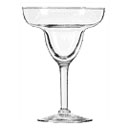
6oz. – 10oz. (177ml – 295ml)Used for serving Frozen cocktails such as Margaritas, or daiquiris.
A coupette and a Margarita glass are distinct types of glassware, each designed for serving specific cocktails. Here are the key features of each:
Coupette Glass:
- Shape: The coupette glass, also known as a saucer glass, has a shallow, wide bowl with a relatively short stem. It somewhat resembles a hybrid between a martini glass and a shallow wine glass.
- Use: Coupette glasses are commonly used for serving a variety of cocktails, including daiquiris, cosmopolitans, and other short and refreshing drinks.
- Rim: Some coupette glasses have an outward-facing rim, which provides a stylish presentation for certain cocktails and allows for creative rimming with sugar or salt.
Margarita Glass:
- Shape: The Margarita glass has a distinctive wide, shallow bowl with a relatively long stem. The wide rim is a key feature, providing space for salt or sugar to be added for rimming.
- Use: Margarita glasses are specifically designed for serving Margaritas, a popular cocktail made with tequila, triple sec, and lime juice. The wide rim allows the drinker to enjoy sips of the cocktail along with the salted or sugared rim.
- Rim: The Margarita glass is known for its salted rim, a classic feature of the Margarita cocktail. The salt enhances the flavors of the drink and provides a pleasant contrast to the sweetness and acidity of the Margarita.
While both coupette glasses and Margarita glasses have wide, shallow bowls, the key distinction lies in the intended use and the presence of a salt or sugar rim. Coupette glasses are more versatile and can be used for a range of cocktails, while Margarita glasses are specifically associated with the Margarita cocktail and its signature rimming.
Overall, the type of glassware used in bars and restaurants depends on the type of establishment and the drinks being served. Choosing the right glassware can make a big difference in the presentation and enjoyment of the drinks.











